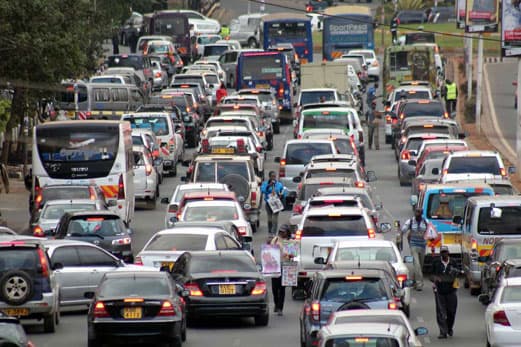Loading News Article...
We're loading the full news article for you. This includes the article content, images, author information, and related articles.
We're loading the full news article for you. This includes the article content, images, author information, and related articles.
Nairobi commuters face daily struggles with severe traffic congestion, transforming routine journeys into hours of stress and lost productivity, impacting both individual livelihoods and the national economy.

For countless Kenyans, navigating Nairobi's roads has become a daily ordeal, marked by extensive delays and unpredictable travel times. What should be a short commute often stretches into hours, leading to exhaustion even before the workday begins. This persistent gridlock is more than an inconvenience; it significantly impacts the rhythm of daily life, causing students to miss classes, employees to lose productive hours, and parents to struggle with family commitments.
The economic ramifications of Nairobi's traffic congestion are substantial. Hours spent in traffic translate directly into lost productivity, missed meetings, and reduced business efficiency. A 2014 government estimate indicated that traffic jams cost Nairobi approximately KSh 50 million (US$578,000) daily in lost productivity. More recent analyses suggest annual wastages of KSh 146.5 billion due to delays and KSh 16.7 billion from wasted fuel. Workers often incur higher transport fares due to longer routes or detours, further straining household budgets.
Socially, the impact is equally profound. Commute delays disrupt family life, lead to missed appointments, and contribute to mental and physical fatigue among residents. Nairobi was ranked the 70th most traffic-congested country globally in 2024, with Kenyans spending over 26 minutes per 10 km commute in traffic. In 2021, data from the Nairobi Metropolitan Region Transportation revealed that passengers spent an average of 57 minutes on the road for distances that should ideally take 10 minutes.
The escalating traffic problem is largely attributed to a continuously increasing number of vehicles on the roads without corresponding effective long-term congestion management strategies. Rapid urbanisation and a growing population, coupled with an increase in private vehicle ownership, exacerbate the issue. Private vehicles accounted for 64% of Nairobi's traffic volume but transported only 22% of commuters in 2021, according to a Kenya Institute for Public Policy Research and Analysis (KIPPRA) study. In contrast, 41% of trips in Nairobi are made by public transport and 40% by foot, as per a 2014 Japan International Cooperation Agency (JICA) Master Plan.
The Kenyan government has acknowledged the urgency of addressing Nairobi's traffic challenges. President William Ruto has outlined a plan to construct at least 70 kilometres of roads in the first phase, aiming to decongest streets, facilitate trade, and spur economic growth. The Ministry of Roads and Transport is also advancing a comprehensive legal reform agenda, including a National Urban Transport Policy to streamline urban mobility amidst rapid urbanisation and climate change.
Efforts to alleviate congestion include significant investments in mass rapid transit systems. The Nairobi Metropolitan Integrated Transport System (NMiTS) is a government-led initiative to overhaul urban mobility, featuring a network of Bus Rapid Transit (BRT) corridors and an expanded commuter rail network. The government secured KSh 219 billion (US$1.7 billion) for Phase 1 of NMiTS, with a goal to move approximately 30,000 people per hour by 2030 via the Nairobi Railway Central Station.
The Cabinet approved a KSh 43.4 billion Clean Bus Rapid Transit (BRT) project in January 2025, financed by the EU, Agence Française de Développement (AFD), and the European Investment Bank. This project aims to connect Ngong Town and Tala, serving an estimated 357,000 passengers daily using electric buses by 2035. The Nairobi Expressway, completed in 2022, was also developed to reduce congestion along Mombasa Road.
Despite these initiatives, challenges persist. Delayed payments to contractors, amounting to KSh 2.9 billion as of December 2024, have led to project stalls and increased costs for the Clean BRT project. Furthermore, while infrastructure spending has often focused on wider roads, experience globally suggests that urban highways alone are insufficient to solve mobility issues. Experts advocate for a shift towards people-focused planning that prioritises public transport, walking, and cycling.
The Nairobi Metropolitan Area Transport Authority (NaMATA), established in 2017, is tasked with coordinating public transport and implementing urban transport policies. NaMATA is working with partners to ensure an integrated approach to planning a complete transport system, including parking reform and a gold-standard BRT system.
The implementation and timely completion of the Clean BRT project and other NMiTS components will be crucial. Monitoring the effectiveness of new road infrastructure in genuinely decongesting the city, rather than inducing more private vehicle use, will also be key. The ongoing legal reforms to update the Traffic Act to accommodate emerging transport technologies, such as electric mobility, are also noteworthy.
Keep the conversation in one place—threads here stay linked to the story and in the forums.
Other hot threads
E-sports and Gaming Community in Kenya
Active 6 months ago
Popular Recreational Activities Across Counties
Active 6 months ago
Investing in Youth Sports Development Programs
Active 6 months ago
The Role of Technology in Modern Agriculture (AgriTech)
Active 6 months ago